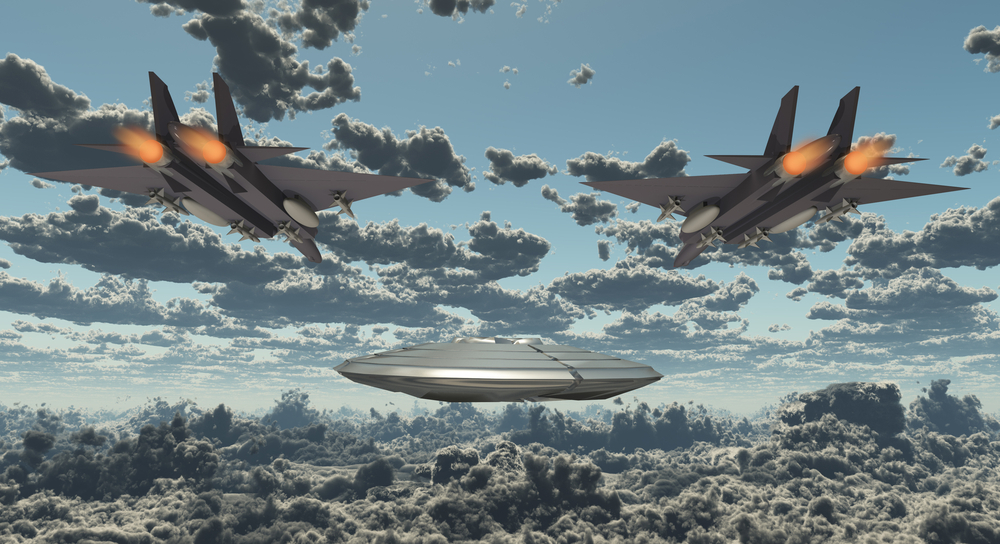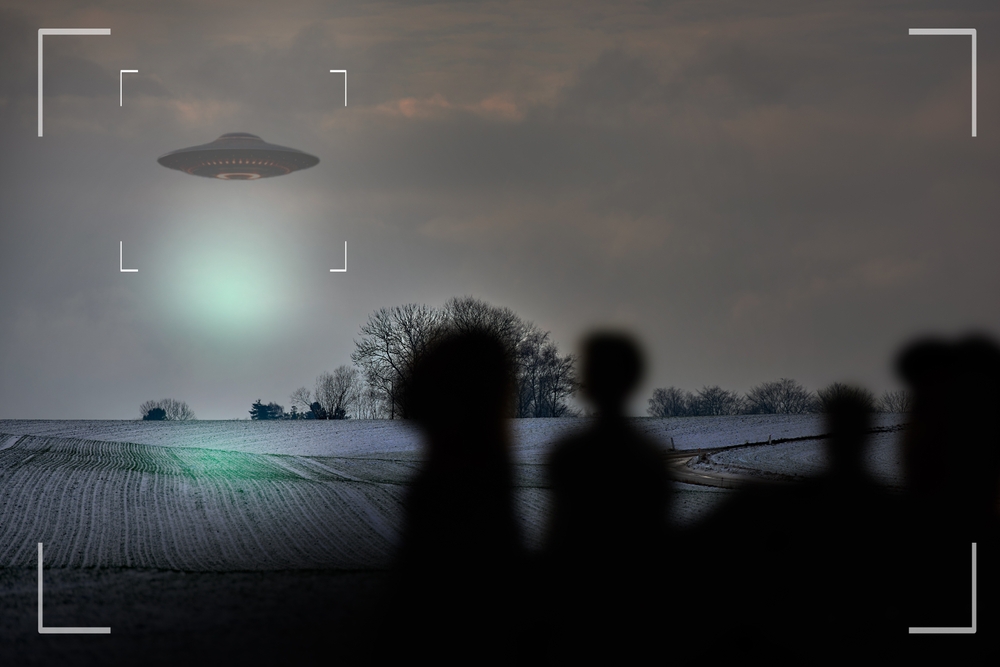Your cart is currently empty!
UFOs Are Swarming U.S. Military Zones—And One Just Crashed Into a Fighter Jet

In a moment that sounds more like a scene from The X-Files than a military report, an F-16 fighter jet flying over Arizona recently collided with an unidentified aerial object during a routine training mission. The object, described by officials as an “orange-white uncrewed aerial system,” struck the jet’s canopy mid-flight—marking one of the most tangible UAP (unidentified aerial phenomena) incidents to date. But as startling as that may seem, it’s just one among hundreds of reported encounters in U.S. restricted airspace in recent years.
Once relegated to fringe conversations, the subject of UFOs—now more neutrally labeled UAPs—has emerged as a legitimate national concern. Military pilots are reporting strange objects at altitudes and speeds well beyond the range of known drones. Government task forces are reviewing hundreds of cases. And public officials are calling for greater transparency and urgency.

A Surge in Midair Encounters Over Military Airspace
In recent years, the skies over restricted U.S. military zones—especially in the Southwest—have seen a dramatic uptick in aerial anomalies. What were once rare curiosities are now becoming regular occurrences. According to official logs, between May 2023 and June 2024 alone, the U.S. government documented 757 sightings of unidentified aerial phenomena (UAP), with only 49 conclusively resolved.
These incidents range in character and complexity. Some are logged as drones or unmanned aerial systems (UAS), but many exhibit characteristics that defy easy classification. Military pilots have described metallic spheres flying in coordinated clusters, glowing objects hovering at commercial jet altitudes, and UAS-like shapes moving at velocities and altitudes inconsistent with known drone capabilities. One pilot reported seeing eight silver aerial objects flying in tight formation at 20,000 feet—well beyond the capabilities of consumer-grade drones, which typically max out under 500 feet and 45 knots (about 52 mph).
A striking case occurred in January during a training mission over Arizona, when an F-16 Viper jet collided mid-flight with an “orange-white uncrewed aerial system.” The object struck the jet’s canopy—raising alarm not only for its presence but for the risk it poses to flight safety and national security. It was just one of four separate encounters logged on that same day.
Former Pentagon investigator Luis Elizondo has called attention to Arizona’s airspace—particularly near the Mexico border—as a “repeat offender” for such sightings. Former U.S. Customs and Border Protection (CBP) official Ron Vitiello points to cartel-funded surveillance drones as one possible explanation. “Maybe they’ve got tech we’re not used to seeing in the drone space,” he said, noting the cartels’ financial motivation to push technological boundaries.
Despite plausible theories, many of these encounters involve performance characteristics or patterns that remain unexplained. Whether adversarial or anomalous in nature, the continued presence of unidentified aerial objects in restricted zones is no longer a fringe concern—it’s a pressing operational challenge.

Beyond Known Technology—What Pilots Are Actually Seeing
While some sightings can reasonably be attributed to drones—particularly in regions where cartel surveillance activity is suspected—many encounters surpass the limits of known commercial or military drone technology. These are not simply off-course hobbyist drones or foreign reconnaissance tools flying a little too close to the line. They demonstrate flight patterns, speeds, and formations that raise fundamental questions about what kind of systems are operating in U.S. airspace—and who controls them.
For instance, pilots have reported objects flying at Mach 0.75 (about 500 mph) at altitudes nearing 33,000 feet. By comparison, most consumer drones struggle to exceed 500 feet in altitude or 45 knots (approximately 52 mph) in speed. In one particularly confounding event on March 25, 2021, two F-35 pilots near Casa Grande, Arizona, encountered a “large white UAS” hovering motionless at 24,000 feet—far beyond the capabilities of even advanced tactical drones, which typically require constant propulsion to remain airborne.
These aren’t isolated sightings. In another case, a glowing blue-green object was observed at 36,000 feet—an altitude typically reserved for commercial aircraft. Such high-altitude, high-speed observations suggest the presence of either exotic technology or systems operating with an unusual degree of sophistication.
While some officials have pointed to cartel innovation as a possible explanation—citing the criminal organizations’ rapid adoption of drone technology to smuggle contraband and conduct surveillance—others, including former Pentagon personnel, caution that this doesn’t account for the flight behavior or radar evasion techniques observed in several reports.
This ambiguity has led to a growing divide in interpretation. Are these craft simply advanced, unmanned aerial vehicles operated by state or non-state actors? Or do they represent something not yet catalogued within our existing frameworks of aerospace engineering? Without hard evidence, officials remain cautious in their conclusions—but the gap between what is known and what is being witnessed continues to widen.

Escalating National Security Risks in Restricted Airspace
The most unsettling aspect of the recent wave of UAP encounters is not just their mysterious nature—it’s their consistent proximity to highly sensitive military zones. These aren’t random sightings in the middle of nowhere. They are happening during live-fire training exercises, surveillance missions, and in regions critical to U.S. defense infrastructure.
The midair collision in January, when an F-16 jet struck an uncrewed aerial system during a routine training flight, underscored a looming threat: unidentified objects are not just being observed—they are now physically interfering with military operations. The jet was hit on the canopy, a vital part of the aircraft that shields the pilot. Though the full extent of the damage has not been disclosed, the incident highlights the very real risk of midair collisions, pilot injury, and mission disruption.
Luis Elizondo, the former head of the Pentagon’s Advanced Aerospace Threat Identification Program (AATIP), has warned that these encounters are occurring “constantly” in places like the Arizona-Mexico border region. Such frequency, coupled with the apparent inability to identify, track, or respond to these craft in real time, raises serious concerns about U.S. airspace sovereignty.
Furthermore, repeated UAP incidents are now burdening military readiness. Pilots are being trained to spot, record, and report unidentified aerial objects while still maintaining their primary mission objectives. In a combat or live-response scenario, this divided attention could prove catastrophic.

Inside the Government’s Struggle to Investigate and Understand UAPs
In response to the rising number of UAP incidents, the U.S. government has taken deliberate, though arguably incremental, steps to confront the issue. In 2020, the Pentagon officially established the Unidentified Aerial Phenomena Task Force (later succeeded by the All-domain Anomaly Resolution Office, or AARO) to standardize reporting and deepen analysis of aerial anomalies encountered by military personnel.
Yet even with these mechanisms in place, transparency and resolution remain elusive. Of the 757 sightings officially recorded between May 2023 and June 2024, only 49 have been closed—meaning the majority still lack definitive explanations. That backlog suggests not only the complexity of the incidents but also the limited capability of current investigative frameworks to make sense of them.
Part of the challenge lies in the diversity of the sightings themselves. Some involve optical anomalies seen visually by pilots; others are radar-confirmed, showing distinct flight paths inconsistent with known aircraft. In some cases, the objects vanish from radar or visual range without a trace, limiting the ability to conduct post-event forensics. Without physical evidence—debris, recovered drones, or clear video—it becomes exceedingly difficult to determine whether these objects represent adversarial systems, misidentified natural phenomena, or something else entirely.
To complicate matters further, there are legal and political sensitivities around intelligence collection, especially when sightings occur near the borders or over domestic territory. As a result, there is often a cautious reluctance to label these incidents definitively—leaving the public and even many within government with more questions than answers.
However, experts emphasize that ambiguity does not equal indifference. The Department of Defense has increased interagency collaboration, sharing UAP data with intelligence agencies, the Federal Aviation Administration (FAA), and Department of Homeland Security, among others. This shift toward a more centralized, scientific, and multi-domain approach reflects growing awareness that these aren’t isolated curiosities—they’re part of a wider pattern that may touch on national security, aerospace safety, and even international diplomacy.
From Curiosity to Urgency—Why UAPs Deserve Serious Attention
What was once dismissed as fringe speculation has moved into the realm of verifiable fact: unidentified aerial objects are appearing with increasing frequency in American airspace, including areas critical to military operations. The crash of a UAS into an F-16 fighter jet wasn’t science fiction—it was logged, confirmed, and left a jet damaged. That reality alone calls for a sober reassessment of how seriously we take these incidents.
The conversation about UAPs has evolved. It’s no longer about little green men or conspiracy theories—it’s about aviation safety, national defense, and technological accountability. Whether these objects are advanced surveillance tools, experimental aircraft, or still-unexplained phenomena, their presence in restricted airspace demands rigorous investigation and clear policy response.
Experts from both within and outside government warn that ignoring these patterns is no longer a viable option. Former Pentagon analysts, defense officials, and aviation authorities are unified in at least one concern: the existing systems for detection, attribution, and response are not yet equipped to handle the complexity of what’s being seen.
Public engagement and oversight can play a vital role here. Just as transparency in other domains—such as cybersecurity or biothreats—has led to more robust infrastructure and preparedness, public scrutiny of aerial anomalies can help shape smarter policy and stronger safeguards.
This moment offers an opportunity to move the discourse forward: from spectacle to strategy, from alarm to accountability. As the skies grow more crowded and the unknowns more pressing, one thing is certain—the time to treat UAPs as a national priority is not sometime in the future. It’s now.
